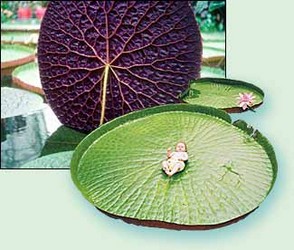
The leaves of Victoria amazonica are so strong that they can support the weight of a human. © 2008 Rupert West
The scientific name of this organism is Victoria amazonica. The common name for this organism is Giant Water Lily.
General Description
Victoria amazonica is in the Plantae kingdom. The flower itself is white and only blooms at night. The colour of the lily changes however when it is pollinated to a pinky purple. When the lily is still white in colour and needs to be pollinated it gives off a butterscotch and pineapple scent that attracts the beetles that pollinate the flower; another way the flower attracts beetles is its power to heat up the core of the flower. If the heat outside is 85°C then inside the flower can be up to 95°C! The flower is approximately the size of a soccer ball and only lives for three days.
The most interesting thing about this flower is the large leaves that it creates. The leaves can grow up to 46 centimeters in size and can hold up to 136 kilograms, the leaves are flat before growing rims at the edge of the leaf. The leaves are strong and stiff thanks to the strong bottom of the leaves. The bottoms are covered with spines to help support the ribs. The bottom of the leaf is maroon in colour. The Giant Water Lily does not grow year round in areas where it is not a native species, such as Great Britain; it only grows and reproduces in the summertime when the climate is warm. However, in its native Brazil and in the Amazon it grows all year long, due to the optimum conditions.
Specific Habitat
The Giant Water Lily grows in the shallow waters of the Amazon River basin, as well as bayous and specific lakes in Brazil. This species is native to Brazil.
Specific Adaptations to the Environment
The Giant Water Lily adapts to the environment by growing thorns on the bottom of the leaves to protect itself from fishes and other predator that might want to eat it. Another adaptation is the rim around the edges of the leaves. These rims help protect the leaf from birds and insects that might want to eat the leaves (the rim is a barrier between the insects and the leaf). The third adaptation of this Giant Water Lily is that the flower only lives for three days, it traps the beetles that come to pollinate the flower inside its core and then releases all its pollen on these beetles. This enlarges the percentage of pollen that gets transported to other flowers for pollination.
Reproductive Characteristics
The Giant Water Lily originates from warm climates of Brazil. There are many beetles living in these warmer climates with the lilies. These beetles pollinate Victoria amazonica, which results in a symbiotic relationship. The way that the pollination works is that the beetle enters the flower and is captured overnight by the flower (the beetles are attracted to the fragrance that the lily gives off). The following day the flower that was once white is now a pinky purple, this is a sign that the flower was pollinated. The beetle is then released from the flower, the beetle emerges from the flower covered in the lily's pollen, and then flies away in the hopes of finding another white lily to pollinate. The flower is then drawn into the water where the seeds develop. This flower does not reproduce asexually; it grows only from seeds.
Importance of the Organism to the Ecosystem
There are two sides to the Giant Water Lily's effect on the ecosystem. The negative part being that no other plant species can live under the Giant Water Lily due to it’s size. The water lily’s leaves are massive in size and they cover most of the surface of the water. This means that no sunlight can reach the rest of the water. Therefore no algae can grow, and with no food source, animals that feed on algae cannot exist. On the other hand, Giant Water Lilies are very helpful to some species, for example the Lily Trotter. The Lily Trotters walk on the leaves and obtain their food source (insects) from the water lily.
Endangerment of the Species
It is not mentioned anywhere that the Victoria amazonica is an endangered species. Therefore it is most likely that it is a common species. These Giant Water Lilies were also brought from their natural habitats to laboratories in England, where researchers are trying to discover more about this particular species and are trying to hybridize these lilies to make different cultivars of the flower.
Taxonomy
Victoria amazonica is classified as a flowering plant, and it is the largest plant in the Nymphaeaceae family of water lilies.
- Kingdom: Plantae
- Phylum: Magnoliophyta
- Class: Magnoliopsida
- Order: Nymphaeales
- Family: Nymphaeaceae
- Genus: Victoria
- Species: Victoria amazonica
- Common Name: Giant Water Lily
ELINA AND THE BEETLE
By: SeoYoun Kim and Katherine Festeryga
There once lived a girl named Elina. She was the size of a thumb! One day Elina decided to go for a walk to clear her head. When she finally realized how far she had walked it was too late to go back. She was lost! Elina tried and tried to find her way back but she just had no recollection of where she should go. Elina decided that it would be best to keep walking and try to find someone to help her find her way home.
Elina walked into a forest filled with wonder. There were bright coloured flowers everywhere as well as many tall trees. By the time she had come to an opening in the forest she was incredibly tired. Elina looked all over to try and find a nice area to sleep in. She finally saw a pond with large round green beds. She decided that it would be in her best interest to take a little nap here on a large green bed.
The next day Elina realized that she had been much more tired than she had initially thought! After Elina had been awake for a few minutes she noticed a beetle walking along on the same bed. The bed was so large though, that they were nowhere near each other, actually she concluded if you weren’t looking for each other, as she was at this point, it would be very hard to see the other object all the way on the other side of the bed.
The beetle however had already spotted Elina and was coming her way and said, “what are you doing here?” Elina was so stunned at this beetle that she quickly responded, “I don’t know. I’m lost!” The beetle was very sympathetic to Elina, he said, “well do you smell that lovely butterscotch and pineapple scent?” Elina sniffed the air and did smell the very fragrant scent. “I smell it! Where is it coming from?” she asked. The beetle pointed to the large white lily that was surrounded by beds just like the one she had slept on. The beetle quickly crawled over to the closest white lily and flew into it!
Elina was amazed, she had never seen anything like this before. After a while the beetle still had not re-emerged from inside the lily. The flower had captured the beetle! “Oh no!” thought Elina. “What is going to happen to the beetle? And how will I ever find my way back home?” Elina was so upset that she sat back down on her large green bed and started to cry. Elina was so disappointed and concerned that she stayed another night on the lily pad.
When she woke up the next day she noticed that the lily had now turned pink! Elina decided to investigate what had happened to the flower. Once Elina had gotten close to the flower she noticed that there was something inside trying to work its way out. “Oh what could it be?” thought Elina. The next thing she knew the beetle had emerged from the flower! Elina was so startled by this; its not everyday, she decided, that you see a beetle emerging from a flower. Elina was about to run ahead and get the beetles attention but what she saw stunned her. She stopped in her tracks. The beetle was covered in yellow fluffy stuff. “What is going on?” Elina thought? “What could be all over the beetle?” Elina was puzzled with this question for a while, but the answer finally came. It was pollen from the flower!
By the time Elina had come to her conclusion about the pollen the beetle had already flown away without even seeing her. Elina’s happiness from her discovery of pollen quickly took a turn for the worse when she realized that she was alone again. She looked out across the lily pad but couldn’t see anyone or anything. “Now how am I supposed to get home?” Elina was devastated by thoughts of being suck on this green bed forever. Soon though Elina’s worries would be over, she just didn’t know it yet.
The lily started to sink! It was hard to see at first because it was very slow. Centimeter by centimeter it seemed to be slowly sinking into the pond. Elina rushed to the edge of the pad to try and see where the lily would go or what would be done to it. She didn’t want to get too close though and be dragged down with it. So she hid behind the edge of the pad. She had not noticed at first but all along the edge of the pad was a thin high green wall, that she thought looked a lot like lettuce. Elina stood quietly there watching this lily sink farther and farther in the water. When the lily was fully submerged in the water Elina finally took her first look over the lettuce edge.
Elina then saw the most beautiful sight! When the lily was submerged in water it looked like the shape of a crown. It was so beautiful! Ellina’s thoughts quickly turned to ones of princes and castles. Suddenly from beneath the lily a tiny figure emerged. It was a prince from the land of fairies. “But where did you come from?” Elina asked. The prince (who was just her size) sat down beside her, “Every time a giant lily goes underneath the water like it just did a prince emerges from my home, the land of the fairies, and comes to the original spot of the lily in hopes of finding a beautiful bride to take home with him.” From that moment on Elina and her prince lived happily ever after in the land of fairies.
THE END
Information on the Internet
- Wikipedia: Victoria amazonica
- Pana`ewa Rainforest Zoo & Gardens: Victoria Water Lily
- YouTube: Amazing! Giant waterlillies in the Amazon From The Private Life of Plants - David Attenborough - BBC wildlife
- The Living Rainforest: The world's greatest lily
- GardeningDaily: Victoria (waterlily)
- Giant Water Lily Crafts Project pdf file
- Qwatra! - Water Garden
- SLRclub.com: Giant water lily


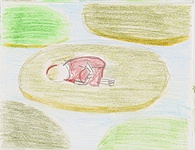
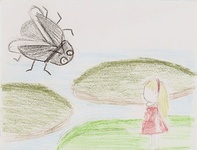
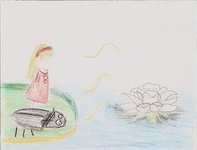
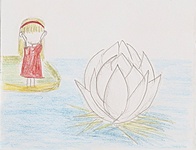
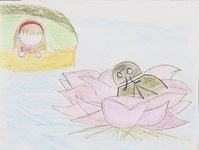
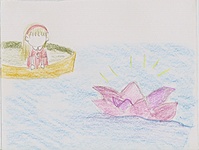



 Go to quick links
Go to quick search
Go to navigation for this section of the ToL site
Go to detailed links for the ToL site
Go to quick links
Go to quick search
Go to navigation for this section of the ToL site
Go to detailed links for the ToL site